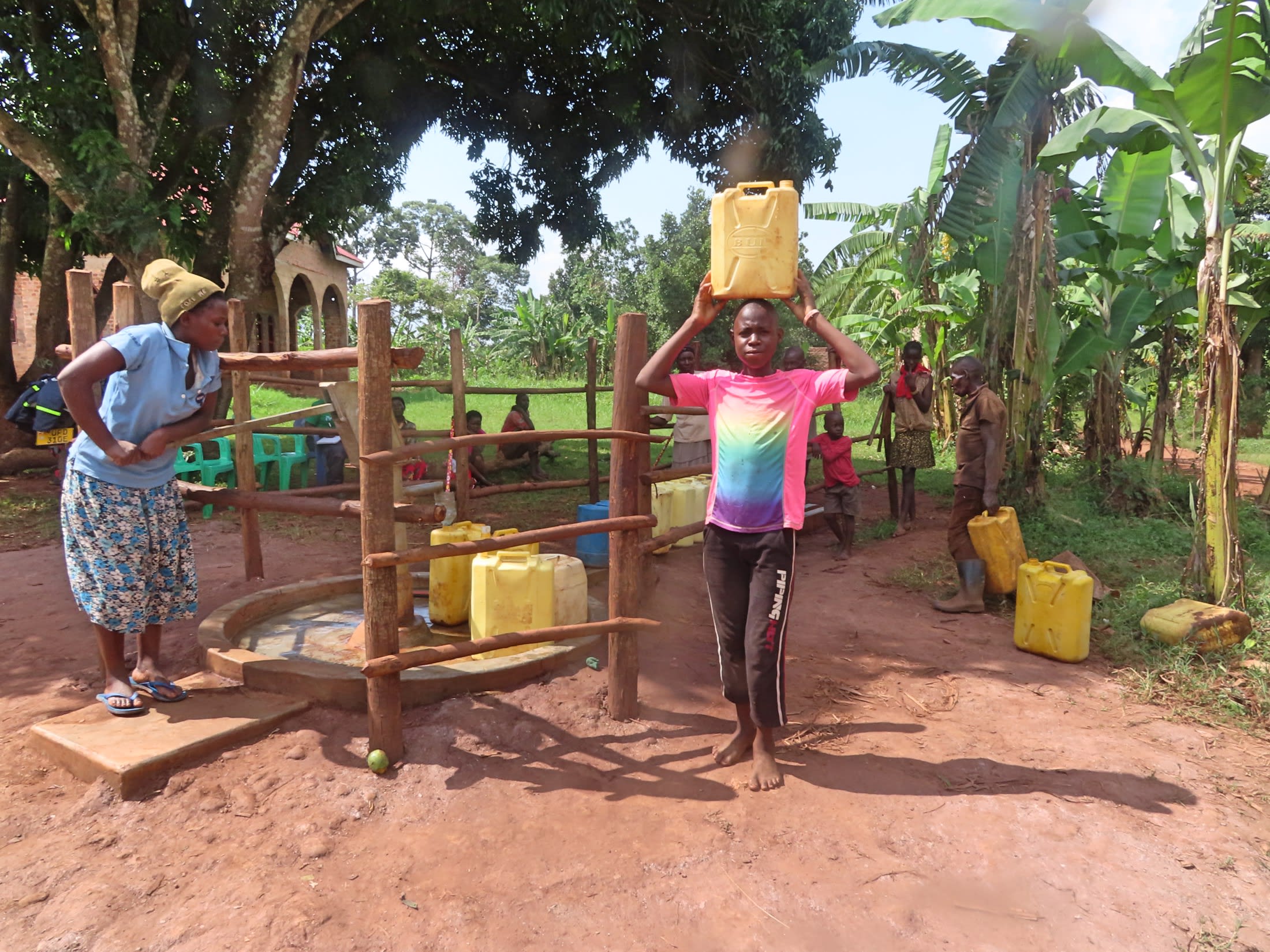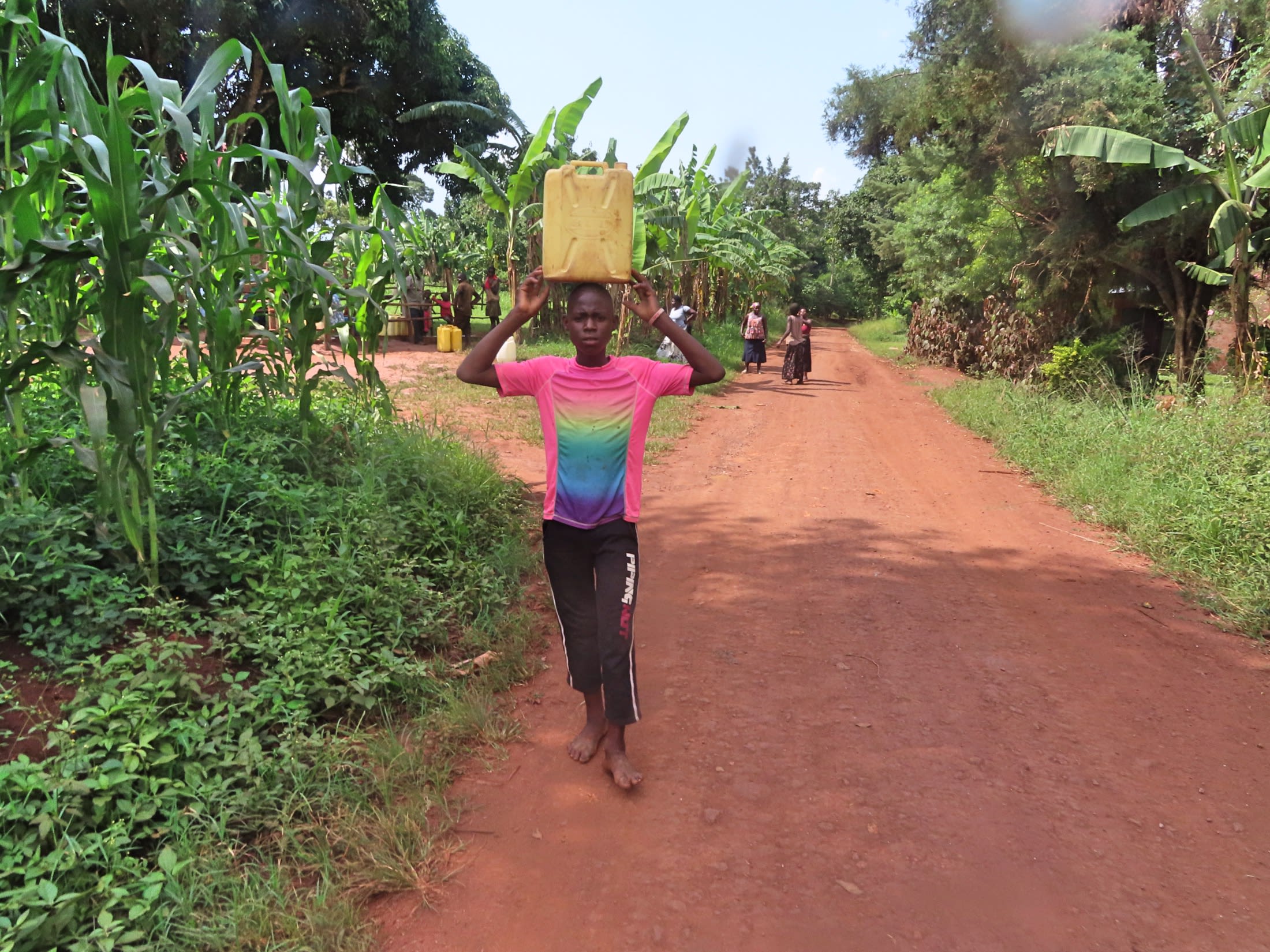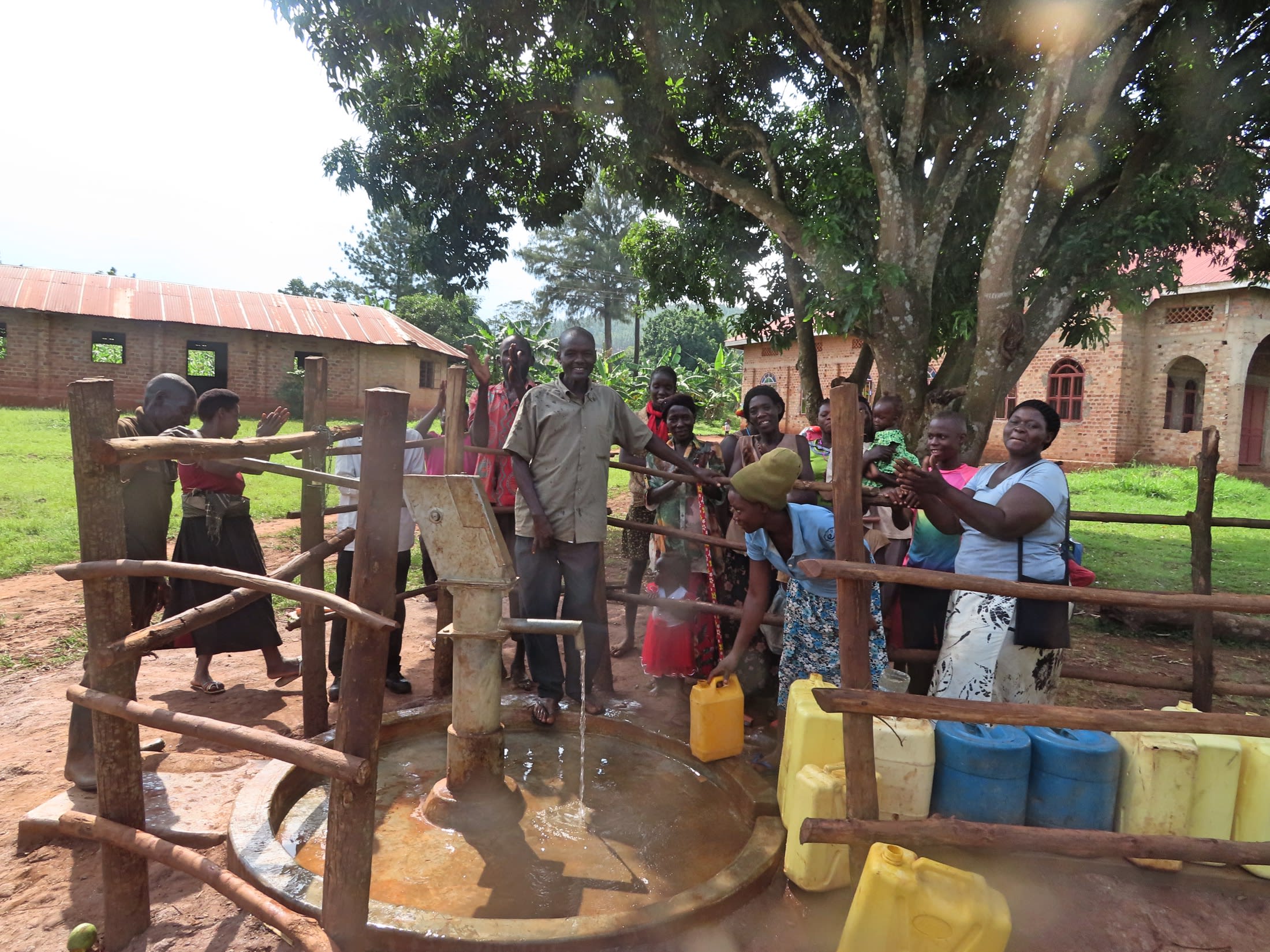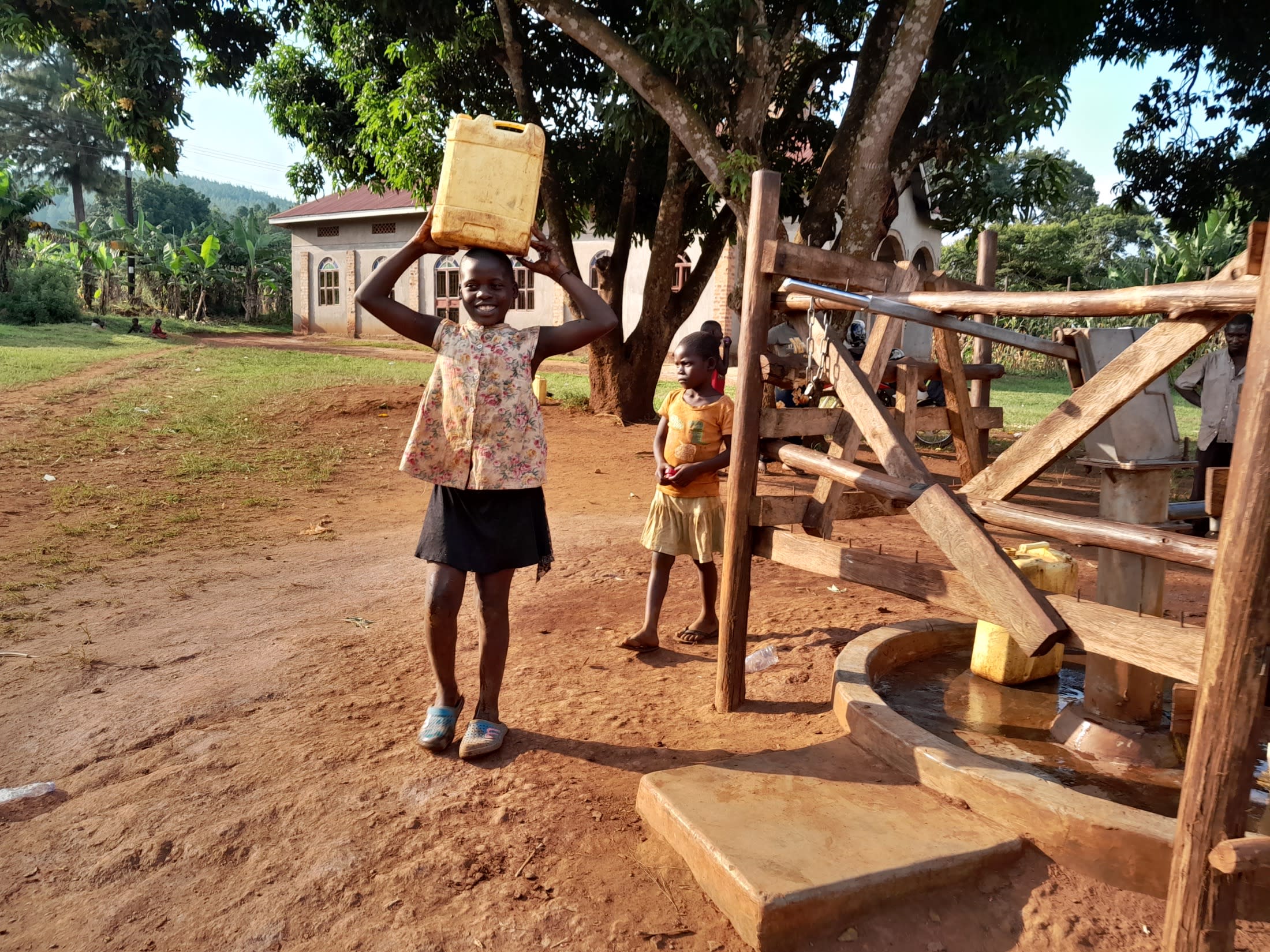The area surrounding the village of Isagara is hilly, fertile, and green with vegetation. A swamp borders the town to the southeast and the Kinyara Sugar Works factory and sugar plantation to the northwest. The village has several sugarcane plantations for commercial purposes and food crops like bananas, maize, beans, cassava, groundnuts (peanuts), and sweet potatoes for subsistence purposes.
The community has only one water point, a local spring, serving 588 people with 98 households. Because there is only one water source, the spring is overcrowded, especially in the evening hours. People spend a lot of productive time, one to three hours on average per trip, collecting water.
Since the area is hilly and the water point is located downstream at the far end of the village, community members must walk long distances to access water. When water flows downstream and into the spring, things become more complicated because the water becomes dirty and contaminated during the rainy season. People must continue to drink the water to survive, but they often suffer from illnesses like typhoid.
Once they wait in line and fill their containers, they must make the difficult return trip uphill. When they have the means, the men in the community use motorcycles, or a family will use their bicycle to help ease the burden of hauling the heavy water, but most are not fortunate enough to have that luxury.

Children often bear the responsibility of collecting water for their families, which they find very challenging. It is not uncommon for them to be late for school or miss classes altogether because it is a long, exhausting, difficult task.
Kyamanywa Docus Nyanjura, a 57-year-old widow raising her five grandchildren, commented, "The village has only one functional water point (a spring), and it is very far. The access road is very poor since it is swampy [and] hilly and even whenever it is rainy season it becomes very impassable."
 She went on to describe the daily struggle. "There is a lot of suffering in as far as access to clean and safe drinking water is concerned. A lot of productive time is wasted in collecting water. I walk a distance of about 2 kilometers (1.24 miles), spending two to three hours to get water home. This makes me, a widow, sometimes stay without water, especially when it is time for school, since it is mainly my grandchildren who help me collect water most times. We indeed need urgent and great assistance for water in this village."
She went on to describe the daily struggle. "There is a lot of suffering in as far as access to clean and safe drinking water is concerned. A lot of productive time is wasted in collecting water. I walk a distance of about 2 kilometers (1.24 miles), spending two to three hours to get water home. This makes me, a widow, sometimes stay without water, especially when it is time for school, since it is mainly my grandchildren who help me collect water most times. We indeed need urgent and great assistance for water in this village."
Here's what we're going to do about it:
New Borehole
This new borehole is an exciting opportunity for this community! We work with the community to determine the best possible sites for this well.
We conducted a hydrogeological survey and the results indicated the water table is an ideal candidate for a borehole well. Due to a borehole well's unique ability to tap into a safe, year-round water column, it will be poised to serve all of the water needs for this community, even through the dry months.
Community members will help collect the needed construction materials such as sand, rocks, and water for mixing cement. They will also provide housing and meals for the work team, in addition to providing local laborers. We will complement their materials by providing an expert team of artisans and drilling professionals, tools, hardware, and the hand-pump. Once finished, water from the well will then be used by community members for drinking, handwashing, cooking, cleaning, and much more.
Training
Training's main objectives are the use of latrines and observing proper hygiene practices since these goals are inherently connected to the provision of clean water. Open defecation, water storage in unclean containers and the absence of hand-washing are all possible contaminants of a household water supply. Each participating village must achieve Open Defecation Free status (defined by one latrine per household) prior to the pump installation for this borehole well.
This social program includes the assignment of one Community Development Officer (CDO) to each village. The CDO encourages each household to build an ideal homestead that includes: a latrine, a handwashing facility, a separate structure for animals, a rubbish pit and a drying rack for dishes.
We also implement the Community-Led Total Sanitation (CLTS) approach with each of our village partners. This aims to improve the sanitation and hygiene practices and behaviors of a village. During these sessions, village leaders naturally emerge and push the community to realize that the current practices of individual households – particularly the practice of open defecation – are not only unhealthy, but affect the entire village. CLTS facilitates a process in which community members realize the negative consequences of their current water, sanitation and hygiene behaviors and are inspired to take action. Group interactions are frequent motivators for individual households to build latrines, use them, and demand that other households do the same.
Improved Sanitation
The aim is that all households own an improved latrine. Many households do not use a latrine but use the bush. Due to open defecation, feces are spread all over the village. This leads to waterborne diseases and contamination of groundwater and surface water. Our aim is that the community is able to live a healthy life free of preventable diseases. We endeavor that at the end of our presence in the community, people will have both access to sustainable, clean water and access to sanitation. We have now organized families to form digging groups for latrine construction, and empowered them with tools to use.

 Borehole Well and Hand Pump
Borehole Well and Hand Pump
 Rehabilitation Project
Rehabilitation Project












 When it came time to build the cement well pad, community members found fine sand and water to mix the cement. After the cement platform dried, we installed a stainless steel Consallen pump, which is now flowing with clean, safe water!
When it came time to build the cement well pad, community members found fine sand and water to mix the cement. After the cement platform dried, we installed a stainless steel Consallen pump, which is now flowing with clean, safe water!













